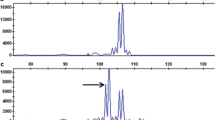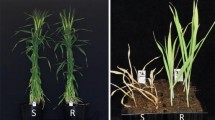Abstract
Two genetically different isolates of the homothallic Oomycete, Phytophthora sojae, were demonstrated to outcross and form hybrid oospores after co-culturing in vitro. Random amplified polymorphic DNA (RAPD) markers revealed ten hybrids among 354 oospores analysed. One F1 hybrid was allowed to self fertilise and produce an F2 population of 247 individuals. Among 53 F2 individuals, selected at random, 18 polymorphic RAPD markers were observed to segregate at near 3:1 Mendelian ratios, consistent with segregation for dominant alleles at single loci. Segregation of virulence against soybean resistance genes Rps1a, 3a, and 5 revealed that the avirulence genes Avr1a, 3a and 5 were dominant to virulence. Avirulence against these three resistance genes appeared to be conditioned by one locus for Avr1a and two independent, complementary dominant loci for both Avr3a and Avr5. Segregation of virulence against Rps6 was in the ratio of 1:2:1 (avirulent:mixed reaction:virulent), suggesting a semi-dominant allele at a single locus. Two avirulence genes and one RAPD marker formed one linkage group, in the order Avr3a, OPH4-1, Avr5, each separated by approximately 5 cM. Our results confirm that outcrossing occurred between the parental isolates, and that sexual recombination under field conditions may play an important role in generating and maintaining genetic diversity in populations of P. sojae.
Similar content being viewed by others
References
Barrett J (1985) The gene-for-gene hypothesis: parable or paradigm. In: Rollinson D, Anderson RM (eds) Ecology and genetics of host parasite interactions. The Linnean Society, London, UK, pp 215–225
Bhat RG, Schmitthenner AF (1993) Exp Mycol 17: 122–129
Chang C, Bowman JL, DeJohn AW, Lander ES, Meyerowitz EM (1988) Proc Natl Acad Sci USA 85: 6856–6860
De Wit PJGM (1992) Annu Rev Phytopathol 30: 391–418
Drenth A, Tas ICQ, Govers F (1994) Europ J Plant Pathol 100: 97–107
Edwards K, Johnstone C, Thomspon C (1991) Nucleic Acids Res 19: 1991
Eye LL, Sneh B, Lockwood JL (1978) Phytopathol 68: 1766–1768
Flor HH (1956) Adv Genet 8: 275–296
Francis DM, St. Clair DA (1993) Curr Genet 24: 100–106
Hansen EM, Maxwell DP (1991) Mycologia 83: 376–381
Heritage AD, Castles CJ, Pierpoint JA (1993) Aust Pl Pathol 22: 131–136
Ilott TW, Hulbert SH, Michelmore RW (1989) Phytopathol 79: 888–897
Irwin JAG, Langdon PW (1982) Aust J Agric Res 33: 33–39
Layton AC, Kuhn DN (1988) Phytopathol 78: 961–966
Michelmore RW, Norwood JM, Ingram DS, Crute IR, Nicholson P (1984) Plant Pathol 33: 301–315
Michelmore RW, Paran I, Kesseli RV (1991) Proc Natl Acad Sci USA 88: 9828–9832
Panabiéres F, Marais A, Trentin F, Bonnet P, Ricci P (1989) Phytopathol 79: 1105–1109
Rose JL, Irwin JAG, Ryley MJ, Langdon PW, Jenner LB (1982) Aust J Agric Res 33: 763–771
Ryley MJ, Obst NR, Stovold GE (1991) Aust Pl Pathol 20: 97–100
Sansome E, Brasier CM (1974) Trans Br Mycol Soc 63: 461–467
Schmitthenner AF (1985) Plant Dis 69: 362–368
Shaw DS (1983) The cytogenetics and genetics of Phytophthora. In: Erwin DC, Bartnicki-Garcia S, Tsao PH (eds) Phytophthora: its biology, taxonomy, ecology, and pathology. Am Phytopathol Soc, St. Paul, Minnesota. pp 81–94
Tooley PW, Sweigard JA, Fry WE (1986) Phytopathol 76: 1209–1212
Ward EWB (1990) The interaction of soya beans with Phytophthora megasperma f. sp. glycinea: pathogenicity. In: Hornby D (ed) Biological control of soil-borne plant pathogens. CAB international, Wallingford, England, pp 311–327
Whisson SC, Maclean DJ, Manners JM, Irwin JAG (1992) Phytopathol 82: 863–868
Whisson SC, Howlett BJ, Liew ECY, Maclean DJ, Manners JM, Irwin JAG (1993) Aust Syst Bot 6: 295–308
Zentmeyer GA (1980) Monogram 10. Am Phytopathol Soc, St. Paul, Minnesota, pp 96
Author information
Authors and Affiliations
Additional information
Communicated by P. J. G. M. de Wit
Rights and permissions
About this article
Cite this article
Whisson, S.C., Drenth, A., Maclean, D.J. et al. Evidence for outcrossing in Phytophthora sojae and linkage of a DNA marker to two avirulence genes. Curr Genet 27, 77–82 (1994). https://doi.org/10.1007/BF00326582
Received:
Accepted:
Issue Date:
DOI: https://doi.org/10.1007/BF00326582




